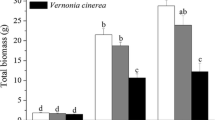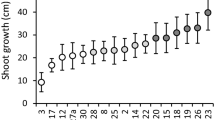Abstract
High-resource environments typically favor quick-growing, poorly defended plants, while resource-poor environments typically favor slow-growing, well-defended plants. The prevailing hypothesis explaining this pattern states that, as resource availability increases, well-defended, slow-growing species are replaced by poorly defended, fast-growing species. A second hypothesis states that greater resource availability increases allocation to growth at the expense of defense, within species. Regardless of mechanism, if exotic species are released from enemies relative to natives, shifts in allocation to growth and defense both within and among species could differ by geographic provenance. To test whether resource availability alters growth or defense, within and among species, and whether any such effects differ between natives and exotics, we manipulated soil nutrient supply and access of aboveground insect herbivores and fungal pathogens under field conditions to individuals of six native and six exotic grass species that co-occurred in a North Carolina old field. The prevailing hypothesis’ prediction—that species-level enemy impact increases with species’ nutrient responsiveness—was confirmed. Moreover, this relationship did not differ between native and exotic species. The second hypothesis’ prediction—that individual-level enemy impact increases with nutrient supply, after accounting for species-level variation in performance—was not supported. Together, these results support the idea, across native and exotic species, that plant species turnover is the primary mechanism underlying effects of nutrient enrichment on allocation to growth and defense in plant communities.




Similar content being viewed by others
Data accessibility
The data supporting these results have been archived on Dryad (https://doi.org/10.5061/dryad.d152444).
References
Agrawal AA (2011) Current trends in the evolutionary ecology of plant defence. Funct Ecol 25:420–432. https://doi.org/10.1111/j.1365-2435.2010.01796.x
Agrawal AA, Kotanen PM, Mitchell CE, Power AG, Godsoe W, Klironomos J (2005) Enemy release? An experiment with congeneric plant pairs and diverse above- and belowground enemies. Ecology 86:2979–2989. https://doi.org/10.1890/05-0219
Allan E, Crawley MJ (2011) Contrasting effects of insect and molluscan herbivores on plant diversity in a long-term field experiment. Ecol Lett 14:1246–1253. https://doi.org/10.1111/j.1461-0248.2011.01694.x
Bastias DA, Martínez-Ghersa MA, Ballaré CL, Gundel PE (2017) Epichloë fungal endophytes and plant defenses: not just alkaloids. Trends Plant Sci 22:939–948. https://doi.org/10.1016/j.tplants.2017.08.005
Bates D, Maechler M, Bolker B (2012) lme4: linear mixed-effects models using S4 classes. R package version 1.1-21. https://CRAN.R-project.org/package=lme4
Blumenthal DM (2006) Interactions between resource availability and enemy release in plant invasion. Ecol Lett 9:887–895. https://doi.org/10.1111/j.1461-0248.2006.00934.x
Blumenthal D, Mitchell CE, Pysek P, Jarosik V (2009) Synergy between pathogen release and resource availability in plant invasion. Proc Natl Acad Sci 106:7899–7904. https://doi.org/10.1073/pnas.0812607106
Chun YJ, van Kleunen M, Dawson W (2010) The role of enemy release, tolerance and resistance in plant invasions: linking damage to performance. Ecol Lett 13:937–946. https://doi.org/10.1111/j.1461-0248.2010.01498.x
Coley PD, Bryant JP, Chapin FS (1985) Resource availability and plant antiherbivore defense. Science 230:895–899. https://doi.org/10.1126/science.230.4728.895
Cronin JP, Rua MA, Mitchell CE (2014) Why is living fast dangerous? Disentangling the roles of resistance and tolerance of disease. Am Nat 184:172–187. https://doi.org/10.1086/676854
Dawson W, Bottini A, Fischer M, van Kleunen M, Knop E (2014) Little evidence for release from herbivores as a driver of plant invasiveness from a multi-species herbivore-removal experiment. Oikos 123:1509–1518. https://doi.org/10.1111/oik.01485
de Mendiburu F (2016) agricolae: Statistical Procedures for Agricultural Research. R package version 1.2-4. https://cran.r-project.org/package=agricolae
Díaz S et al (2016) The global spectrum of plant form and function. Nature 529:167–171. https://doi.org/10.1038/nature16489
Didiano TJ, Turley NE, Everwand G, Schaefer H, Crawley MJ, Johnson MTJ (2014) Experimental test of plant defence evolution in four species using long-term rabbit exclosures. J Ecol 102:584–594. https://doi.org/10.1111/1365-2745.12227
Dostál P, Allan E, Dawson W, van Kleunen M, Bartish I, Fischer M (2013) Enemy damage of exotic plant species is similar to that of natives and increases with productivity. J Ecol 101:388–399. https://doi.org/10.1111/1365-2745.12037
Endara MJ, Coley PD (2011) The resource availability hypothesis revisited: a meta-analysis. Funct Ecol 25:389–398. https://doi.org/10.1111/j.1365-2435.2010.01803.x
Fine PVA, Mesones I, Coley PD (2004) Herbivores promote habitat specialization by trees in Amazonian forests. Science 305:663–665. https://doi.org/10.1126/science.1098982
Fine PVA et al (2006) The growth-defense trade-off and habitat specialization by plants in Amazonian forests. Ecology 87:S150–S162. https://doi.org/10.1890/0012-9658(2006)87%5b150:tgtahs%5d2.0.co;2
Grover JP (1997) Resource competition. Springer Science & Business Media, Berlin
Hahn PG, Maron JL (2016) A framework for predicting intraspecific variation in plant defense. Trends Ecol Evolut 31:646–656. https://doi.org/10.1016/j.tree.2016.05.007
Halbritter AH, Carroll GC, Gusewell S, Roy BA (2012) Testing assumptions of the enemy release hypothesis: generalist versus specialist enemies of the grass Brachypodium sylvaticum. Mycologia 104:34–44. https://doi.org/10.3852/11-071
Halliday FW, Heckman RW, Wilfahrt PA, Mitchell CE (2019) Past is prologue: host community assembly and the risk of infectious disease over time. Ecol Lett 22:138–148. https://doi.org/10.1111/ele.13176
Heckman RW, Wright JP, Mitchell CE (2016) Joint effects of nutrient addition and enemy exclusion on exotic plant success. Ecology 97:3337–3345. https://doi.org/10.1002/ecy.1585
Heckman RW, Halliday FW, Wilfahrt PA, Mitchell CE (2017) Effects of native diversity, soil nutrients, and natural enemies on exotic invasion in experimental plant communities. Ecology 98:1409–1418. https://doi.org/10.1002/ecy.1796
Heger T, Jeschke JM (2014) The enemy release hypothesis as a hierarchy of hypotheses. Oikos 123:741–750. https://doi.org/10.1111/j.1600-0706.2013.01263.x
Herms DA, Mattson WJ (1992) The dilemma of plants: to grow or defend. Q Rev Biol 67:283–335. https://doi.org/10.2307/2830650
James C (1971) A manual of assessment keys for plant diseases Publication 1458. American Phytopathological Society, St. Paul
Joern A (1979) Feeding patterns in grasshoppers (Orthoptera: acrididae): factors influencing diet specialization. Oecologia 38:325–347. https://doi.org/10.1007/BF00345192
Joshi J, Vrieling K (2005) The enemy release and EICA hypothesis revisited: incorporating the fundamental difference between specialist and generalist herbivores. Ecol Lett 8:704–714. https://doi.org/10.1111/j.1461-0248.2005.00769.x
Kattge J et al (2011) TRY – a global database of plant traits. Glob Change Biol 17:2905–2935. https://doi.org/10.1111/j.1365-2486.2011.02451.x
Komsta L (2013) mblm: Median-based linear models. R package version 0.12. https://CRAN.R-project.org/package=mblm
Kuznetsova A, Brockhoff PB, Christensen RHB (2016) lmerTest: tests in linear mixed effects models. R package version 2.0-32
Leishman MR, Cooke J, Richardson DM (2014) Evidence for shifts to faster growth strategies in the new ranges of invasive alien plants. J Ecol 102:1451–1461. https://doi.org/10.1111/1365-2745.12318
Lind EM et al (2013) Life-history constraints in grassland plant species: a growth-defence trade-off is the norm. Ecol Lett 16:513–521. https://doi.org/10.1111/ele.12078
Madden LV, Hughes G, Bosch F (2007) The study of plant disease epidemics. American Phytopathological Society (APS Press), St Paul
Mitchell CE, Power AG (2003) Release of invasive plants from fungal and viral pathogens. Nature 421:625–627. https://doi.org/10.1038/nature01317
Mitchell CE, Tilman D, Groth JV (2002) Effects of grassland plant species diversity, abundance, and composition on foliar fungal disease. Ecology 83:1713–1726. https://doi.org/10.1890/0012-9658(2002)083%5b1713:eogpsd%5d2.0.co;2
Mitchell CE, Reich PB, Tilman D, Groth JV (2003) Effects of elevated CO2, nitrogen deposition, and decreased species diversity on foliar fungal plant disease. Glob Change Biol 9:438–451. https://doi.org/10.1046/j.1365-2486.2003.00602.x
Mitchell CE et al (2006) Biotic interactions and plant invasions. Ecol Lett 9:726–740. https://doi.org/10.1111/j.1461-0248.2006.00908.x
Mitchell CE, Blumenthal D, Jarošík V, Puckett EE, Pyšek P (2010) Controls on pathogen species richness in plants’ introduced and native ranges: roles of residence time, range size and host traits. Ecol Lett 13:1525–1535. https://doi.org/10.1111/j.1461-0248.2010.01543.x
Moles AT et al (2011) Putting plant resistance traits on the map: a test of the idea that plants are better defended at lower latitudes. New Phytol 191:777–788. https://doi.org/10.1111/j.1469-8137.2011.03732.x
Napier JD, Mordecai EA, Heckman RW (2016) The role of drought- and disturbance-mediated competition in shaping community responses to varied environments. Oecologia 181:621–632. https://doi.org/10.1007/s00442-016-3582-9
Parker IM, Gilbert GS (2007) When there is no escape: the effects of natural enemies on native, invasive, and noninvasive plants. Ecology 88:1210–1224. https://doi.org/10.1890/06-1377
Parker IM et al (2015) Phylogenetic structure and host abundance drive disease pressure in communities. Nature 520:542–544. https://doi.org/10.1038/nature14372
Pearson DE, Callaway RM, Maron JL (2011) Biotic resistance via granivory: establishment by invasive, naturalized, and native asters reflects generalist preference. Ecology 92:1748–1757. https://doi.org/10.1890/11-0164.1
Pérez-Harguindeguy N et al (2013) New handbook for standardised measurement of plant functional traits worldwide. Aust J Bot 61:167–234. https://doi.org/10.1071/bt12225
Revell LJ (2012) phytools: an R package for phylogenetic comparative biology (and other things). Method Ecol Evol 3:217–223. https://doi.org/10.1111/j.2041-210X.2011.00169.x
Seabloom EW et al (2015) Plant species’ origin predicts dominance and response to nutrient enrichment and herbivores in global grasslands. Nat Commun 6:7710. https://doi.org/10.1038/ncomms8710
Seabloom EW, Borer ET, Kinkel LL (2018) No evidence for trade-offs in plant responses to consumer food web manipulations. Ecology 99:1953–1963. https://doi.org/10.1002/ecy.2389
Siemann E, Carson WP, Rogers WE, Weisser WW (2004) Reducing herbivory using insecticides. In: Weisser WW, Siemann E (eds) Insects and Ecosystem Function. Springer-Verlag, Berlin, pp 302–327
Simko I, Piepho H-P (2012) The area under the disease progress stairs: calculation, advantage, and application. Phytopathology 102:381–389. https://doi.org/10.1094/phyto-07-11-0216
Stamp N (2003) Out of the quagmire of plant defense hypotheses. Q Rev Biol 78:23–55. https://doi.org/10.1086/367580
Stricker KB, Stiling P (2012) Herbivory by an introduced Asian weevil negatively affects population growth of an invasive Brazilian shrub in Florida. Ecology 93:1902–1911. https://doi.org/10.1890/11-1328.1
Stricker KB, Harmon PF, Goss EM, Clay K, Luke Flory S (2016) Emergence and accumulation of novel pathogens suppress an invasive species. Ecol Lett 19:469–477. https://doi.org/10.1111/ele.12583
Throop HL, Lerdau MT (2004) Effects of nitrogen deposition on insect herbivory: implications for community and ecosystem processes. Ecosystems 7:109–133. https://doi.org/10.1007/s10021-003-0225-x
Tscharntke T, Greiler HJ (1995) Insect communities, grasses, and grasslands. Ann Rev Entomol 40:535–558. https://doi.org/10.1146/annurev.en.40.010195.002535
van Kleunen M, Weber E, Fischer M (2010) A meta-analysis of trait differences between invasive and non-invasive plant species. Ecol Lett 13:235–245. https://doi.org/10.1111/j.1461-0248.2009.01418.x
Van Zandt PA (2007) Plant defense, growth, and habitat: a comparative assessment of constitutive and induced resistance. Ecology 88:1984–1993. https://doi.org/10.1890/06-1329.1
Veresoglou SD, Barto EK, Menexes G, Rillig MC (2013) Fertilization affects severity of disease caused by fungal plant pathogens. Plant Pathol 62:961–969. https://doi.org/10.1111/ppa.12014
Warton DI, Duursma RA, Falster DS, Taskinen S (2012) smatr 3– an R package for estimation and inference about allometric lines. Methods Ecol Evol 3:257–259. https://doi.org/10.1111/j.2041-210X.2011.00153.x
Webb CO, Donoghue MJ (2005) Phylomatic: tree assembly for applied phylogenetics. Mol Ecol Notes 5:181–183. https://doi.org/10.1111/j.1471-8286.2004.00829.x
Wise MJ, Abrahamson WG (2005) Beyond the compensatory continuum: environmental resource levels and plant tolerance of herbivory. Oikos 109:417–428. https://doi.org/10.1111/j.0030-1299.2005.13878.x
Wright IJ et al (2004) The worldwide leaf economics spectrum. Nature 428:821–827. https://doi.org/10.1038/nature02403
Zhang Z, Pan X, Blumenthal D, Kleunen M, Liu M, Li B (2018) Contrasting effects of specialist and generalist herbivores on resistance evolution in invasive plants. Ecology 99:866–875. https://doi.org/10.1002/ecy.2155
Acknowledgements
We thank J. Bruno, J. Cronin, E. Mordecai, R. Peet, M. Rua, M. Welsh, J. Umbanhowar, P. Wilfahrt, and J. Wright for advice on the design and analysis of this study. L. Fridie, T. Hodges, A. Kinniburgh, J. Napier, E.A. Reece, M. Sandoval, and S. Tolar assisted with field and lab work. This study was funded by a Doctoral Dissertation Improvement Grant to CEM and RWH (NSF-DEB-1311289). UNC’s Alma Holland Beers Scholarship and WC Coker Fellowship provided summer funding to RWH. FWH was supported by the NSF GRFP.
Author information
Authors and Affiliations
Contributions
RWH and CEM designed the study; RWH performed the study, analyzed the data, and wrote the first draft of the manuscript; FWH enemy identified and quantified damage, and analyzed damage data; all authors revised the manuscript.
Corresponding author
Ethics declarations
Conflict of interest
The authors declare no conflict of interest.
Additional information
Communicated by Katherine L. Gross.
Electronic supplementary material
Below is the link to the electronic supplementary material.
Rights and permissions
About this article
Cite this article
Heckman, R.W., Halliday, F.W. & Mitchell, C.E. A growth–defense trade-off is general across native and exotic grasses. Oecologia 191, 609–620 (2019). https://doi.org/10.1007/s00442-019-04507-9
Received:
Accepted:
Published:
Issue Date:
DOI: https://doi.org/10.1007/s00442-019-04507-9




